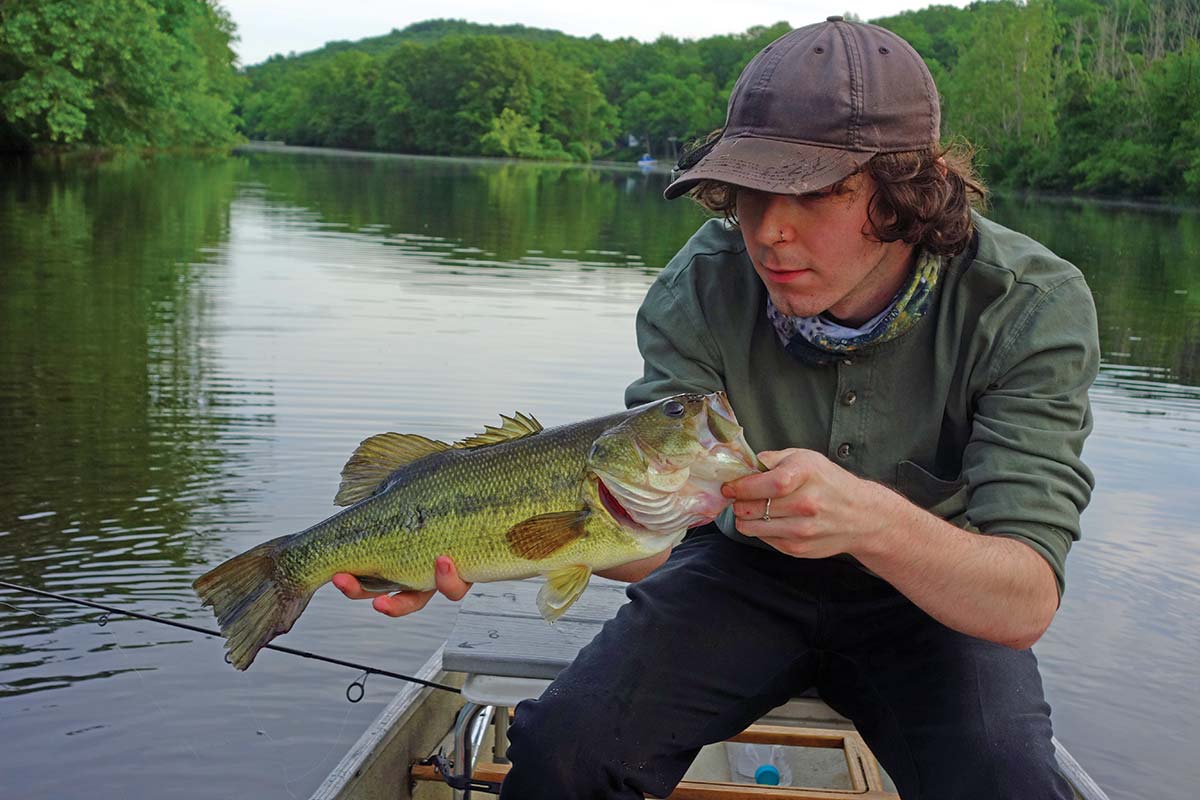
Take every opportunity to observe fish in their natural habitat.
To maximize success, an angler should take in as much information while on the water as possible. An incredibly fruitful opportunity any detail-oriented fisher person should take advantage of is the time spent actually watching fish behave in the water. Regardless of your target species, tackle of choice, or home waters, actually seeing the fish is not only highly enjoyable but one of the best learning experiences an angler can have. It leads to detailed understanding of fish behavior. The sight-fishing angler gets to see fish react to everything around them, from the lure, bait or fly that the angler presents to them, to that angler themselves, or to the actual structure of the waterbody they live in. Sight fishing may in fact be the most efficient way to learn how fish react to your actions. Additionally, recognizing their cues of interest or disinterest will become applicable for other species in both fresh and salt water. Over and above all that, it’s just flat-out fun.
As a guide, I am charged with the task of keeping my clients engaged, and that isn’t always easy with certain species and scenarios that don’t lend themselves to constant catching. I quickly gravitated to sight fishing. If the client can see the fish, they are engaged in the process. If I can see the fish I feel more engaged as well… I also have more control over the outcome. In the backwaters of the Connecticut River where I spend much of my spring and summer season, there exist a substantial number of species that all can be sight-fished. From the obscure bowfin and channel catfish to the ubiquitous and gigantic common carp, and even the oft targeted but less regularly sight fished largemouth and smallmouth bass, options abound for pursuing your quarry visually. And this is far from the only place it exists. From the vegetated backwaters of Lake Champlain to retention ponds in south Florida, opportunities to sight-fish to freshwater quarry abound. Though each species or water may require slightly different approaches and presentations, there are broadly applicable concepts to learn about sight fishing that will benefit any angler anywhere in the fishing world.
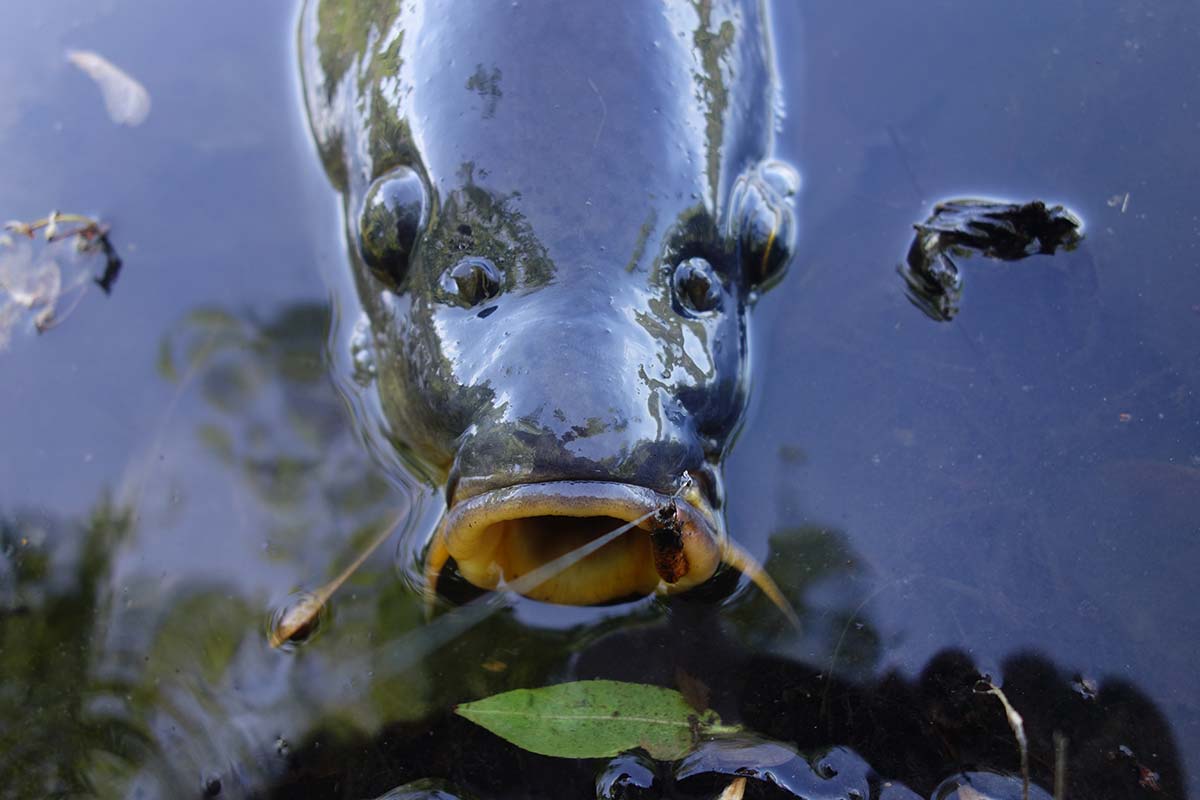
Body Language
Like any animal, fish display body language. They can move fins, re-position themselves, and even contort their bodies in ways that will tell the angler looking at them what they might be about to do next. It takes time to understand the body language of each species, but if you are aware that it exists and can be read, you can start learning from every visual interaction you get with a fish. Traversing a trout stream with a client one day, we came to stop at a large bend pool with a sandy bottom. On the inside of the bend sat a substantial brown trout for that water, a fish of maybe 17 or 18 inches. The fish was sitting in a slow seam and stuck out like a sore thumb over the uniform bottom in that bright light. It was almost plastered to the bottom and hardly moving a fin. It held its body in a slightly curved shape, with its tail kicked off to the right.
My client could see the fish as clearly as I could and was eager to make a cast. “Not worth it” I cautioned him. “Why not, that’s a nice fish?” he asked. “It’s either already aware of us or was spooked before we got here” I warned, “Do you see how its body is held tense and curved? All it needs to do right now to leave its spot there is one kick of the tail”. A disturbed trout will often hold in a curved position like that. It’ll be hyper aware of any disturbance and likely bolt at the slightest sign of danger. It also certainly isn’t in a feeding mood. Indeed, I let my client make a cast and though the presentation was plenty passable and would likely have converted an undisturbed trout, this one bolted the moment the fly landed. A trout holding in the current a bit off the bottom, tail kicking gently, or one that occasionally moves off station to grab something in the drift is a fish that can be caught. One sitting on bottom with its body curved and not moving at all is a trout that is already on edge and ready to bolt for cover. Save your time and energy and move on to the next fish.
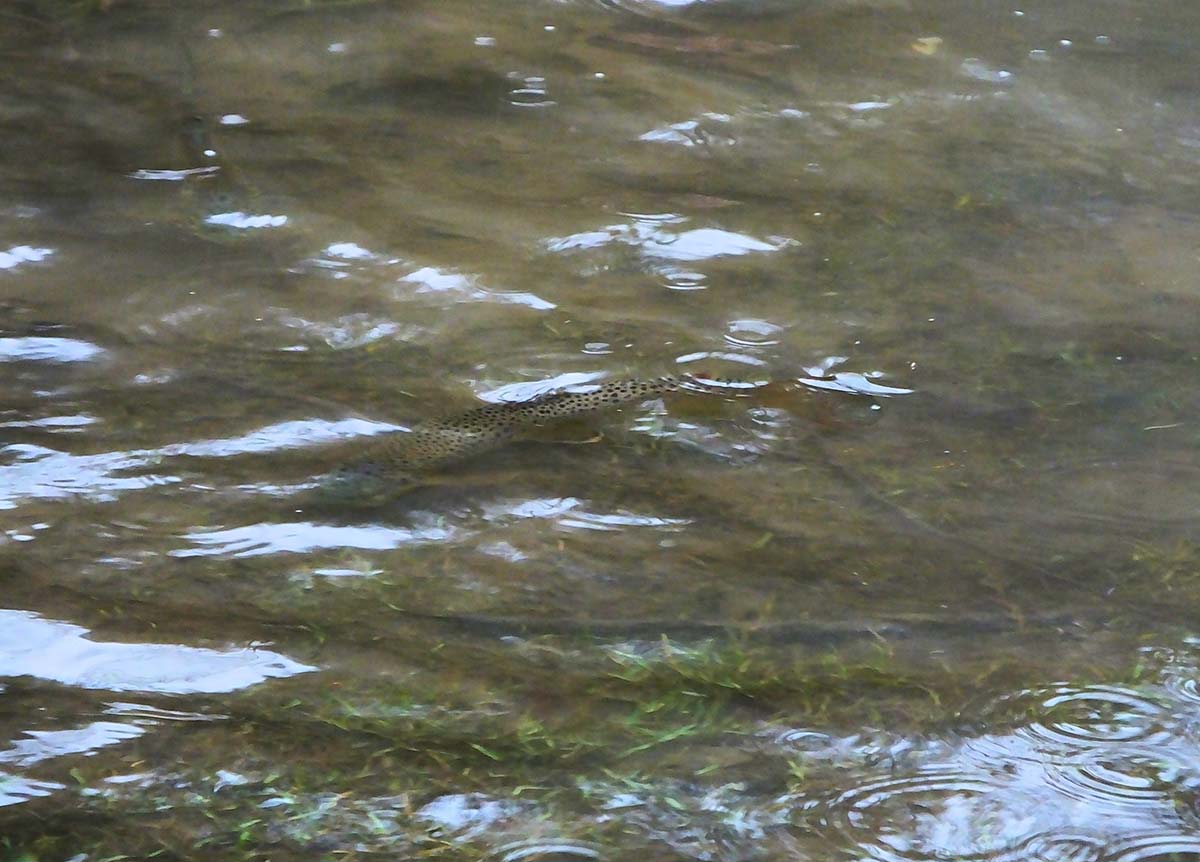
Readying For A Strike
Body language can also teach you whether a fish is about to eat your offering. Bowfin have grown in popularity in recent years and are a perfect example. They’re also an incredibly expressive fish. Though individualistic – each bowfin acts a little differently – they do often give off incredible body language that they’re about to strike your lure. One of the bowfin’s most unique traits is their incredibly elongated dorsal fin. Stretching along almost half of their body length, this is a very visible trait and can clue an angler in when a bowfin is excited. Bowfin that are intrigued by a lure will usually begin to undulate that dorsal fin like a wave. It’s visually quite spectacular and often followed by a jarringly explosive take. If a bowfin doesn’t start undulating its dorsal fin it may take a bit more coaxing to get it to take. They can certainly still be converted but it may take some work.
With bowfin, the take is almost always very obvious. That isn’t always true of other species. Common carp frequently live in and even create muddy water with their bottom rooting, so a sight fisherman may be able to see a lot of a carp without having eyes on their mouth. They may also only be visible from their tailing behavior. Carp feeding in shallow water often push their tail above the surface as they feed on the bottom. The inability to actually see the fish’s head can make detecting a strike tricky, but carp have tells as well. A vivid memory of my early years targeting carp with a fly rod involved a monster fish in about two feet of water, tailing gently. At about 20-feet away the fish wasn’t visible through the glare, just her tail at the surface. A delicate cast led the fish by about 8 inches. Right around the time I suspected the fly should be falling into the zone, the tail made a clear and abrupt jump forward with two kicks, then stopped and almost quivered for a second. A lift of the rod and the fish was on. The tail had told me everything I needed to know. Watching the tails of carp whose mouths I couldn’t see has put me and plenty of clients onto bites that would otherwise have been undetectable. This same behavior can be applied to saltwater applications too with species like permit, bonefish, and redfish.
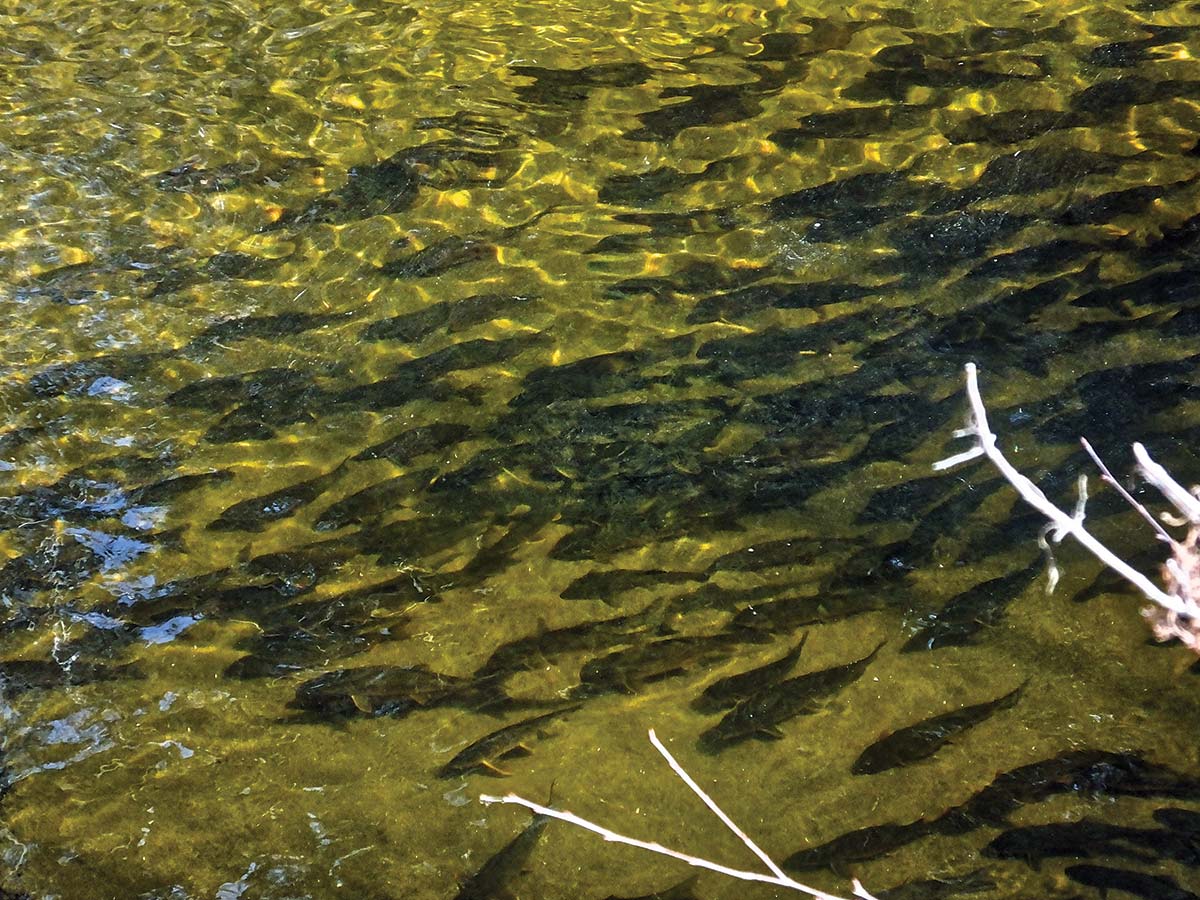
Patterning By Sight
As well as teaching an angler how to tell if a fish might be willing to eat, that it is about to take, or that it already has taken, sight fishing can teach the keen observer a lot about how fish negotiate through their habitat. Fish have rhyme and reason for their movements. They rarely move without purpose and careful observation can often reveal details that will make it easier to catch them. This sort of sight fishing often forces the angler to put the rod down for a while and just watch. It can be tough, but there is so much to be learned that it is most definitely worth it. One bright September day on a crystal clear Connecticut pond, I was targeting largemouth bass. The portion of the pond I was on featured a moderately shallow back-bay connected to the main basin by a narrow channel. The water was down a bit and the banks were steep and devoid of any taller vegetation. Blind fishing had proved less productive than I’d hoped.
Sitting up away from the water taking stock of the situation, I noticed a school of five or six largemouth coming down the channel. They were leaving the shallow bay and appeared to be on the hunt; moving slowly but with purpose along one contour, maybe three feet off the bottom and following the gradient of the bank. In front of me was a bit of a rise, sort of a gravel bar that came up to about seven inches deep. On that bar was a school of banded killifish. When the school got to the bar the lead two bass rushed in and made an attack on the killies, a hit and run if you will. They got one or two and re-joined their school, continuing out and around the tip of the shallow bar and out into the main lake. Curious to see if this school or another might make a similar route, I took a position at the water’s edge. From there I could cast to the corner where the bar met the bank and head off the fish. It wasn’t more than five minutes before three big bass came sliding down that edge. An accurate cast to that corner was quickly intercepted by the lead fish.
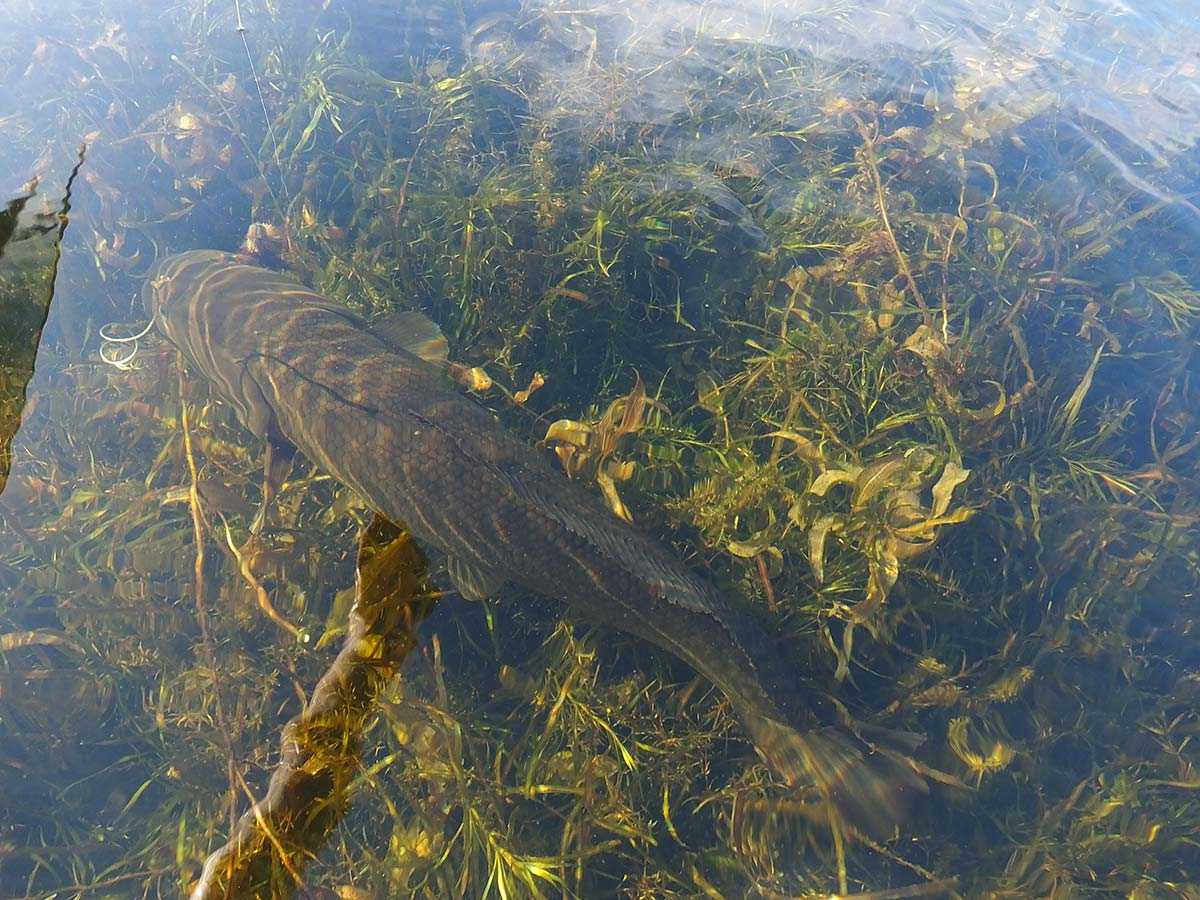
From that day onward, late summer days never failed to produce good numbers of bass at that location simply because I’d happened to watch a school perform what turned out to be a routine pattern in that body of water. Whether the conditions allowed me to see them or not, they always came down that edge moving the same direction and made their way around the gravel bar. Traveling fish will follow depth contours like those bass were. They’ll also use weed edges, current seams, shadow lines and other forms of delineation in a body of water. Watching fish follow these paths will reveal points of vulnerability. Perhaps, as with those bass, there’s a spot where forage often concentrates. Maybe it’s a place where the fish have to round a physical barrier. At times, it could be a narrow choke point that concentrates traveling fish. In some cases it may be as simple as the fish traveling past one spot from which it’s much easier to cast to them in an otherwise brush and snag filled environment. Watching the fish and finding these vulnerable spots along their path of travel can really set the angler that sight fishes apart from the one who doesn’t.
Sight fishing has long been popular in certain realms of fishing. It gets associated with certain species, like tarpon or redfish, and certain water types like big shallow flats. It’s far more broadly applicable than that, though, and any angler targeting any species can benefit from watching their quarry behave naturally in its surroundings. The scenarios discussed here are some of the highlights, sure, but there is so much more to be learned from watching the fish. I find I learn something useful almost every time the opportunity to sight fish arises. It really is the perfect setup for an angler: you get to observe your quarry, learn from its actions, and try to anticipate its next move. As the puzzle gets pieced together, you pick the moment to present the lure, fly, or bait, and if all goes well you get the ultimate confirmation: watching the fish react, pursue and eat your offering. What, in fishing, is more rewarding than that?



